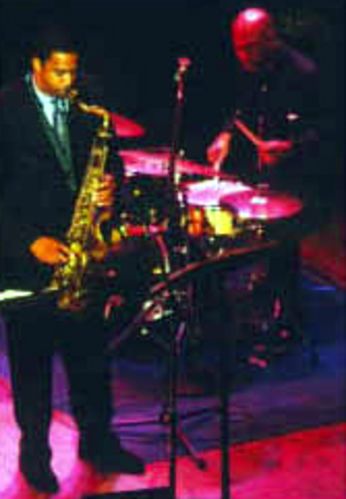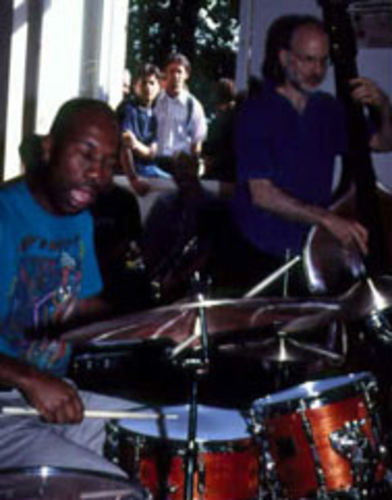Snared by Jazz: Ron Savage

Savage accompanies saxophonist and alumnus Javon Jackson.
Photo by Kim Grant

Savage and fellow faculty member Dave Clark demonstrate rhythm section playing in Italy.
Photo by Rob Hayes
It wasn't until he was a teenager that Ron Savage tuned into jazz. Literally.
"The radio station I grew up with went off when the sun went down," says Savage, who spent his adolescence in the small town of Ahoskie, North Carolina. "My younger brother was into electronics, and we kind of expanded the coil of our radio so we could get stations in Norfolk, Virginia. We could get Richmond late at night."
At first, his dial brought forth sleepy string arrangements of contemporary pop tunes, the kind of music usually confined to grocery stores, Macy's show rooms, and, of course, elevators.
"But we thought that was jazz," says Savage, who had been drumming in funk and r&b bands since he was 13, "because it wasn't what we were used to, and it was instrumental. So, we assumed a violin version of a Lionel Richie song was jazz."
But over time, these stations mended their ways, and Savage was listening to Grover Washington, Spyro Gyra, Ronnie Laws, and the Crusaders, among others. This music had life. Much of it was pop or r&b inflected and an innovative take on the music Savage had grown up with. But it wasn't until his late teens that his revelation was broadcast.
"When I was 16 or 17, one of these stations played [John Coltrane's] 'My Favorite Things'," Savage says, "and when I heard that—and I had no clue what it was—it just preempted everything. That music was me."
So Savage, who at times considered becoming a sociologist, a history teacher, or an architect, made his final choice with ease.
"When I really thought about it, it was music by a landslide," he says.
But sometimes it's simpler to make a decision than to execute it. One band director served all the schools in the county—he was the wrestling coach, too. Savage had been mostly self-taught, but he realized that if he wanted to really embrace jazz, he would need the right training. He enrolled in a Berklee summer program, figuring that a few weeks would be enough to help him decide whether he would want a few years. He made up his mind in three days.
"I thought that a person like me belonged in a place like this," says Savage. "In a small town, when you talked about music, people saw it as a little hobby. They said, 'Why would you waste your parents' money like this?'"
Actually, it's been money well spent. Since his student days, Savage has gone on to perform with Cyrus Chestnut, Christian McBride, Bill Pierce, and many others, and to record with artists such as Christopher Hollyday, Cecilia Smith, and Patrice Williamson.
But Savage, who's been on the Berklee faculty for seven years, has been teaching about as long as he's been playing. Even when he was 13, he'd teach younger kids beats on the drum set. In college, Savage covered his tuition costs by tutoring for a college preparatory program at Massachusetts Institute of Technology—biology, English, Spanish, Latin—everything but the uppermost levels of math. He says he's always liked opening young minds to new ideas, though that might not be the only reason he got into education.
"My wife tells me it's because I like talking so much," Savage says.
And when your audience consists of Italian students, your translator has to keep up. This summer, Savage and other Berklee faculty members held clinics as part of Umbria Jazz, one of Europe's largest and most prestigious jazz festivals. The 2000 installment of Umbria Jazz marked Savage's seventh appearance at the event, and over the years he's realized that students are the same wherever they are.
"Teaching is teaching," he says. "People have trouble with the same fundamentals—tone, maintaining a good feel, consistent tempo, playing as a band and interpreting the music in the same way—I start from there."
Ron Savage has a new outlook on samba rhythms. He has traditionally devoted some of his Umbria clinics, in Perugia, Italy, to Latin music and usually focuses on helping his students coordinate the different sounds on the drum set. But a visit to Brazil helped him realize that the samba is less a particular pattern of beats than it is a feeling. To get that point across to his students, Savage has decided to deconstruct the samba, dividing his class into sections representing each of the style's rhythmic subdivisions.
He has the students on the snare drums, which correspond to the Brazilian caixa, lay down the foundation pulse. Two of the students are pounding floor toms, the surdo and contrasurdo. One takes the downbeat and the other the backbeat, a thumping back-and-forth. He has the students without drums infuse the syncopation by striking their sticks together. The class stays hooked into the groove, even when Savage pushes the tempo. But though they're playing simultaneously, they don't seem to be playing as one.
"We have to listen to each other to play together," he says, his words recast into Italian by his assistant, Marco Volpe '84. "Everything that we play has got to fit with the feeling of what we're playing on the snare drum."
He wants to hear just the snares. If the rhythm's core isn't tight, there's no point in embellishing it. He wants to hear the snare beats played on the rim so he can hear the articulation distinctly. He doesn't like it.
"We're bringing our grace note hands too high," he says. "Remember, we talked about leaving our hands—upstrokes, downstrokes—in the correct position to play the right articulation. . . . We have to make sure our accents are lining up."
He counts the class in again, but stops the groove almost immediately.
"Come on, now. Move to the edge of your chair. Just because we're playing a samba doesn't mean we have to have bad posture, bad technique."
In the next attempt, it's the surdos that trip up the rhythm. The conversation between the two big drums has deteriorated, and both instruments are speaking at once.
"The drums are talking to each other. Bang, boom! Bang, boom! Bang, boom, buh-buh-buh boom! Then the dancers get into it," Savage says, with a shimmy of his own.
His adjustments work, and during the next go-around he lets some of his students solo through the breaks. Then he passes out some sheet music and passes along some advice.
"Playing a samba is a feeling more than a special drum beat," he says. "As long as you have the different voices, the vocabulary of the rhythm, how you decide to orchestrate on the drum set will be determined by how you feel about the music being played at the moment."
"By the way," he adds, "you can put the sheet music away. We just played everything on there."
